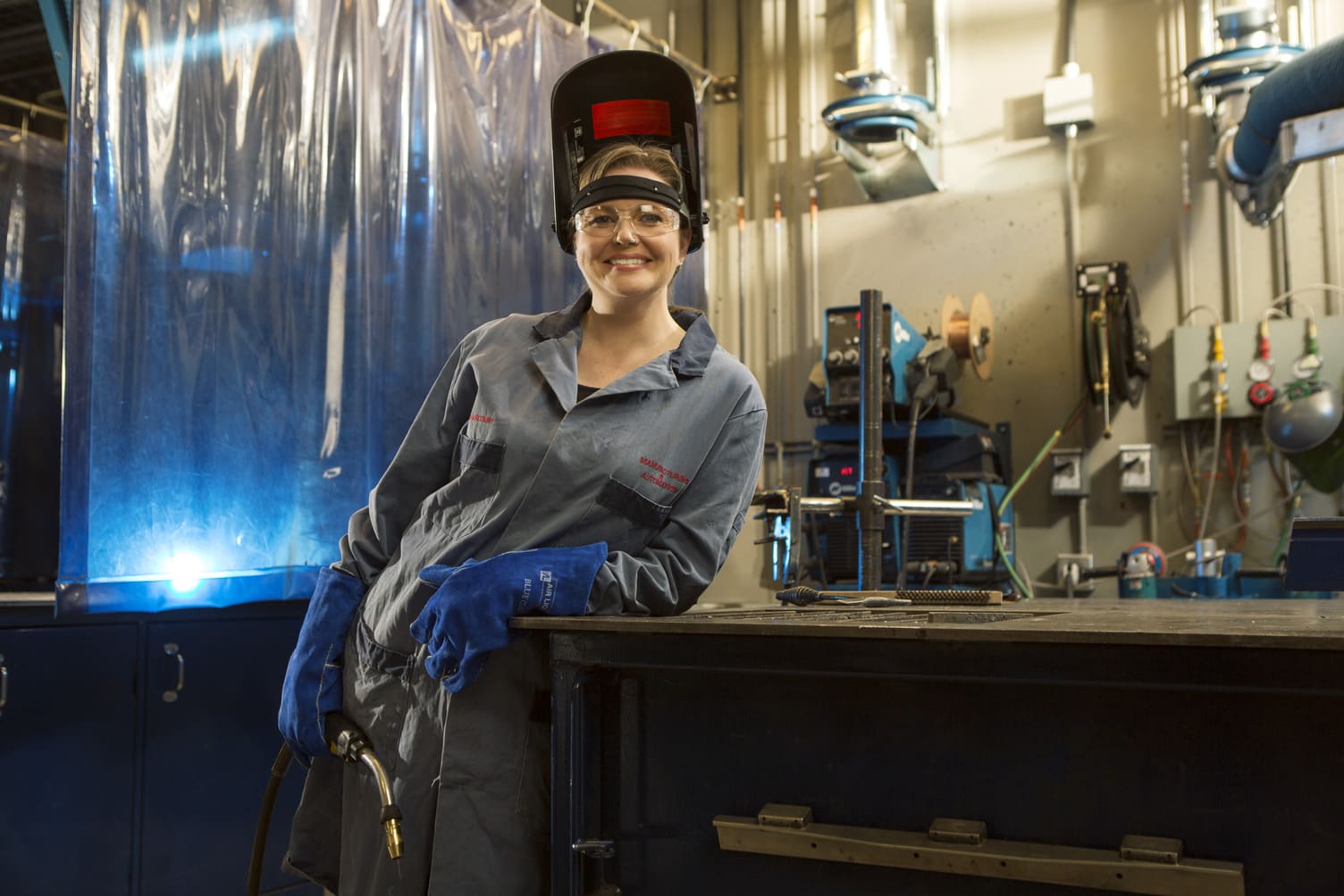On this page:
Overview
Learn to prepare food for hotels, restaurants and other establishments.
If you like a challenge, are passionate about food and enjoy working in a fast-paced environment, you’ll enjoy a career as a cook. Cooks ensure the food is nutritious, inexpensive, and prepared safely.
Depending on the establishment, you may study menus to estimate food requirements and obtain the necessary food from storage or suppliers. You’ll also wash, peel and cut vegetables, clean and cut meat, fish and poultry and keep kitchen equipment and cooking utensils clean.
You may also be involved in preparing, seasoning and cooking such foods as soups, salads, meats, fish, gravies, vegetables, desserts, sauces and casseroles, baking pastries, preparing portions on a plate and adding gravies, sauces and garnish to servings.
Throughout your career, you may also prepare buffets (for example, platters and showpieces) and special diets, oversee menu planning, regulate stock control and supervise kitchen staff.
While specific duties vary depending on the type of establishment, it is your responsibility to create appealing and healthy meals.

At SAIT, instructors and leaders don’t just teach great hospitality — they live it. In 2025, SAIT tops the CEOWORLD Magazine’s list of the Best Hospitality and Hotel Management Schools in the World, moving to 13 — from 14 in 2024 — and holding strong as the number one in Canada.

Cooks love to share their passion for food, have a knack for creativity, are self-motivated and can work collaboratively. If you enjoy working in fast-paced environments and like challenges, you’ll excel in this line of work.
To succeed in this trade, it's important to:
- have basic math skills
- be interested in preparing food
- enjoy working with other people
- be in good health and can stand for long periods
- have a keen sense of taste and smell
- be a team player, but you can also work independently
- be willing to maintain the high standard of cleanliness necessary in any food establishment
- be creative
- be committed to maintaining safe work habits.
Upon successfully completing the required working hours and technical training periods, you'll be awarded a diploma in addition to journeyperson status by Alberta’s Apprenticeship and Industry Training.
This is a Red Seal Endorsed trade – a recognizable standard that allows tradespeople to work across Canada.
Careers and opportunities
Our graduates may work in the following occupations. Some careers require additional experience and education.
Associated National Occupational Classification (NOC) codes: 60030, 62020, 62200, 63200, 65201.
Apprenticeship training
The term of apprenticeship for a cook is three years (three 12-month periods), including a minimum of 1560 hours of on-the-job training and eight weeks of apprenticeship education at SAIT each year.
Year 1 | Period 1
You’ll learn about safety, kitchen orientation and trade mathematics. You’ll also cover an introduction to butcher shop practices, cooking proteins, saucier, cold kitchen, bakeshop and breakfast, beverages and dairy products.
Training length: 8 weeks
Year 2 | Period 2
You’ll learn management controls and nutritional components, cooking proteins, saucier, entremetier, cold kitchen and bakeshop.
Training length: 8 weeks
Year 3 | Period 3
You’ll learn management skills, preparing and cooking proteins, entremetier, saucier, liquor products, garde manger and patisserie.
Training length: 8 weeks
Weeky Apprenticeship Training System (WATS)
The Weekly Apprenticeship Training System (WATS) delivers shorter segments spread out over an extended period. This approach allows you to remain employed full-time while pursuing your training.
Year one of the program begins with a two-week Monday-to-Friday schedule, then switches to a Monday-only class.
Year two of the program begins with a one-day-per-week class delivery and then switches to a Tuesday-only class.
Year three of the program begins with a one-day-per-week class delivery and then switches to a one-week block delivery. Later, the program switches once more to a Wednesday-only class.
Apprenticeship education performance
You must pass each section of the course and the AIT exam to succeed in apprenticeship education.
The passing grade for each period is no less than 50% in each course, with no less than a 65% average overall. A passing mark on each provincial exam and the interprovincial qualification (Red Seal Exam) is 70%.
View Alberta's Apprenticeship and Industry Training procedures
Training pathways
You can earn your journeyperson designation in the following way.
The traditional training pathway begins with finding a job with an employer willing to indenture you as an apprentice. Once you’re an apprentice, you’ll alternate between on-the-job training and educational periods.
You must apply for an apprenticeship through Alberta Apprenticeship and Industry Training before attending your first education period at SAIT.
SAIT’s Culinary Arts two-year diploma is accredited for all three technical training periods.
You’ll still be required to complete 4,680 hours of paid work experience and must successfully challenge all three provincial exams before being considered eligible for the Red Seal exam and designation.
Admission requirements
To enter an apprenticeship, you need the required educational qualifications or recommended education for the trade to which you apply.
Alberta Apprenticeship and Industry Training sets and monitors entrance requirements.
Minimum requirements
Successful completion of the following courses:
- English 10-2
- Math 10-3
OR
A pass mark in all five Canadian General Educational Development (GED) tests
OR
Alberta Apprenticeship and Industry Training entrance exam
Recommended requirements
Apprentices with an Alberta High School diploma that includes the following courses:
- English 30-2
- Math 30-3
- Physics 20 OR Chemistry 20 OR Science 20
- Related career and technology studies (CTS) courses

MyTradeSecrets
Once you have begun working as an apprentice, you can attend SAIT to complete your technical training.
You'll register for technical training at SAIT on MyTradeSecrets or you can register by phone.
Transfer agreements
At SAIT, we have created transfer agreements with partner institutions to allow you to earn course credits toward your SAIT program based on your previously completed credentials.
Transfer Alberta search tool
Use the Transfer Alberta search tool to see all transfer agreements between Alberta post-secondary institutions (including those with the University of Calgary, Mount Royal University and Bow Valley College.)
Search transfer agreements in Alberta
There are no formal transfer agreements currently in place for this program.
Transfer options for graduates
When you have completed this program, you may continue your education at a partner post-secondary institution. These transfer agreements include partnerships within and/or outside of Canada.
Credits this program transfers to
- Available credits:
- 45 credits
Upon successful completion of this apprenticeship program, graduates with at least five years of work experience and a provincial or inter-provincial certificate of qualification held for at least one year are eligible to apply for the Bachelor of Business Administration in Trades Management degree at the University of the Fraser Valley.
- Available credits:
- 42
- Available credits:
- 45
Available intakes
Costs
2025/26 tuition and fees
The following costs are effective as of July 1, 2025.
The below tuition and fee structure is based on standard delivery/block release training periods. Please contact us for costs associated with the WATS delivery program.
*You are required to pay a $75 laundry fee per technical training period.
This is a bring-your-own-device program with a standard computer hardware and software requirement. See the specific requirements on our computers and laptops page.
Books or modules, along with other items for classes, are approximately $600 per period.
We recommend you don't purchase books or modules ahead of time as they might be outdated by the time you attend classes, and they cannot be returned to the Bookstore.
This program requires personal protective equipment (PPE), which may be an additional cost.

Funding options for apprentices
Apprentices get to learn while they earn, but there are still costs to consider. Many resources are available at SAIT and federally to help support apprentices.
Information sessions
Prepare for a strong start in your chosen program or get the details you need to decide your future path.
Our expert staff and faculty are ready to answer your questions and provide information about the following:
- What sets SAIT apart
- An introduction to the program and area of study
- Admission requirements
- Future career paths
- Information on the earning potential and graduate employment rates.
Contact
Have more questions?
Technical training at SAIT
School of Hospitality and Tourism
-
Phone - 403.284.8612
-
Email - hospitality.info@sait.ca
Apprenticeship training and registration
Apprenticeship and Industry Training Client Services

Oki, Âba wathtech, Danit'ada, Tawnshi, Hello.
SAIT is located on the traditional territories of the Niitsitapi (Blackfoot) and the people of Treaty 7 which includes the Siksika, the Piikani, the Kainai, the Tsuut’ina and the Îyârhe Nakoda of Bearspaw, Chiniki and Goodstoney.
We are situated in an area the Blackfoot tribes traditionally called Moh’kinsstis, where the Bow River meets the Elbow River. We now call it the city of Calgary, which is also home to the Métis Nation of Alberta.
